recommended oil NISSAN 370Z COUPE 2012 Owners Manual
[x] Cancel search | Manufacturer: NISSAN, Model Year: 2012, Model line: 370Z COUPE, Model: NISSAN 370Z COUPE 2012Pages: 427, PDF Size: 3.25 MB
Page 295 of 427
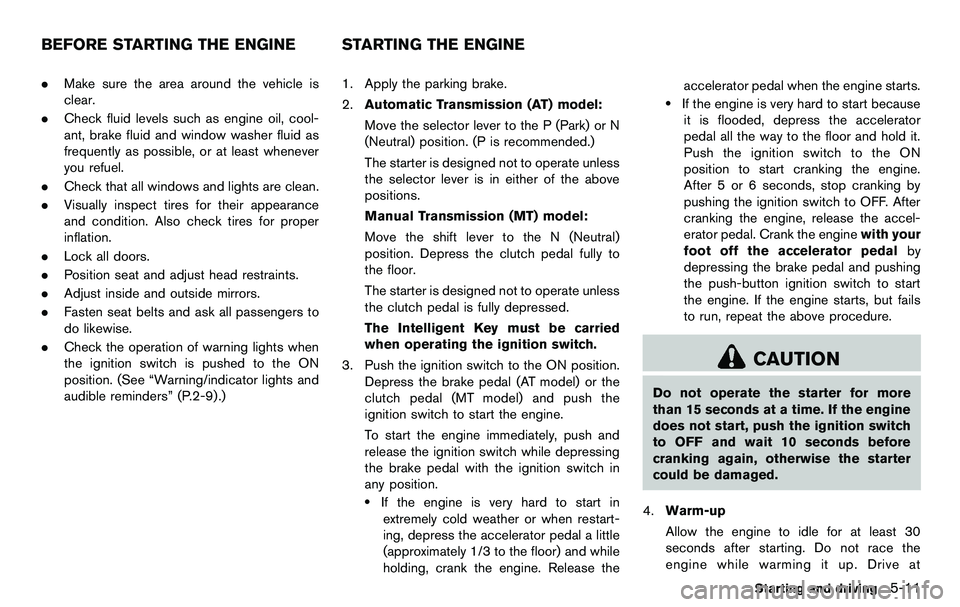
.Make sure the area around the vehicle is
clear.
. Check fluid levels such as engine oil, cool-
ant, brake fluid and window washer fluid as
frequently as possible, or at least whenever
you refuel.
. Check that all windows and lights are clean.
. Visually inspect tires for their appearance
and condition. Also check tires for proper
inflation.
. Lock all doors.
. Position seat and adjust head restraints.
. Adjust inside and outside mirrors.
. Fasten seat belts and ask all passengers to
do likewise.
. Check the operation of warning lights when
the ignition switch is pushed to the ON
position. (See “Warning/indicator lights and
audible reminders” (P.2-9) .) 1. Apply the parking brake.
2.
Automatic Transmission (AT) model:
Move the selector lever to the P (Park) or N
(Neutral) position. (P is recommended.)
The starter is designed not to operate unless
the selector lever is in either of the above
positions.
Manual Transmission (MT) model:
Move the shift lever to the N (Neutral)
position. Depress the clutch pedal fully to
the floor.
The starter is designed not to operate unless
the clutch pedal is fully depressed.
The Intelligent Key must be carried
when operating the ignition switch.
3. Push the ignition switch to the ON position. Depress the brake pedal (AT model) or the
clutch pedal (MT model) and push the
ignition switch to start the engine.
To start the engine immediately, push and
release the ignition switch while depressing
the brake pedal with the ignition switch in
any position.
.If the engine is very hard to start inextremely cold weather or when restart-
ing, depress the accelerator pedal a little
(approximately 1/3 to the floor) and while
holding, crank the engine. Release the accelerator pedal when the engine starts.
.If the engine is very hard to start because
it is flooded, depress the accelerator
pedal all the way to the floor and hold it.
Push the ignition switch to the ON
position to start cranking the engine.
After 5 or 6 seconds, stop cranking by
pushing the ignition switch to OFF. After
cranking the engine, release the accel-
erator pedal. Crank the engine with your
foot off the accelerator pedal by
depressing the brake pedal and pushing
the push-button ignition switch to start
the engine. If the engine starts, but fails
to run, repeat the above procedure.
CAUTION
Do not operate the starter for more
than 15 seconds at a time. If the engine
does not start, push the ignition switch
to OFF and wait 10 seconds before
cranking again, otherwise the starter
could be damaged.
4. Warm-up
Allow the engine to idle for at least 30
seconds after starting. Do not race the
engine while warming it up. Drive at
Starting and driving5-11
BEFORE STARTING THE ENGINE STARTING THE ENGINE
Page 325 of 427
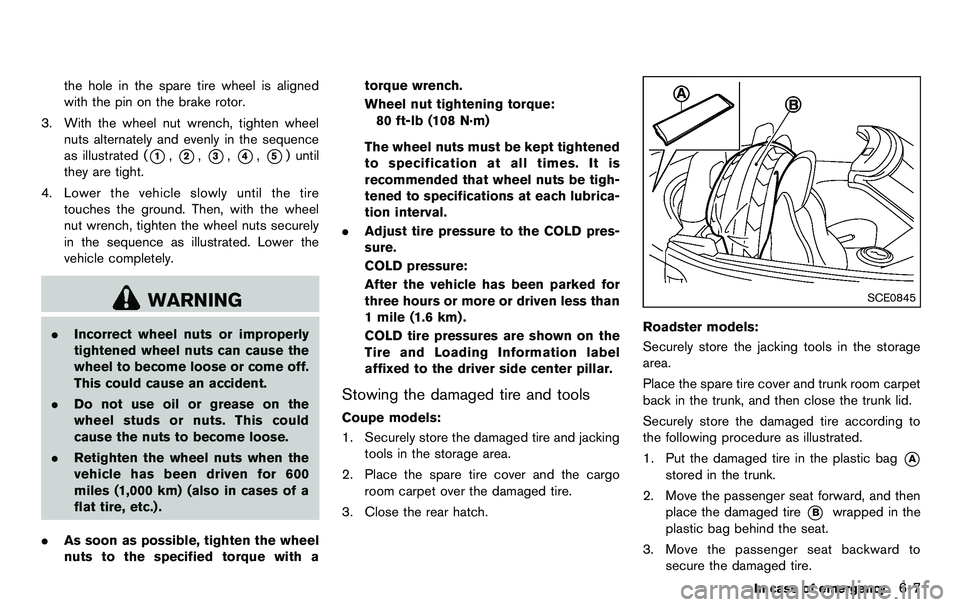
the hole in the spare tire wheel is aligned
with the pin on the brake rotor.
3. With the wheel nut wrench, tighten wheel nuts alternately and evenly in the sequence
as illustrated (
*1,*2,*3,*4,*5) until
they are tight.
4. Lower the vehicle slowly until the tire touches the ground. Then, with the wheel
nut wrench, tighten the wheel nuts securely
in the sequence as illustrated. Lower the
vehicle completely.
WARNING
.Incorrect wheel nuts or improperly
tightened wheel nuts can cause the
wheel to become loose or come off.
This could cause an accident.
. Do not use oil or grease on the
wheel studs or nuts. This could
cause the nuts to become loose.
. Retighten the wheel nuts when the
vehicle has been driven for 600
miles (1,000 km) (also in cases of a
flat tire, etc.) .
. As soon as possible, tighten the wheel
nuts to the specified torque with a torque wrench.
Wheel nut tightening torque:
80 ft-lb (108 N·m)
The wheel nuts must be kept tightened
to specification at all times. It is
recommended that wheel nuts be tigh-
tened to specifications at each lubrica-
tion interval.
. Adjust tire pressure to the COLD pres-
sure.
COLD pressure:
After the vehicle has been parked for
three hours or more or driven less than
1 mile (1.6 km) .
COLD tire pressures are shown on the
Tire and Loading Information label
affixed to the driver side center pillar.
Stowing the damaged tire and tools
Coupe models:
1. Securely store the damaged tire and jacking
tools in the storage area.
2. Place the spare tire cover and the cargo room carpet over the damaged tire.
3. Close the rear hatch.
SCE0845
Roadster models:
Securely store the jacking tools in the storage
area.
Place the spare tire cover and trunk room carpet
back in the trunk, and then close the trunk lid.
Securely store the damaged tire according to
the following procedure as illustrated.
1. Put the damaged tire in the plastic bag
*A
stored in the trunk.
2. Move the passenger seat forward, and then place the damaged tire
*Bwrapped in the
plastic bag behind the seat.
3. Move the passenger seat backward to secure the damaged tire.
In case of emergency6-7
Page 346 of 427
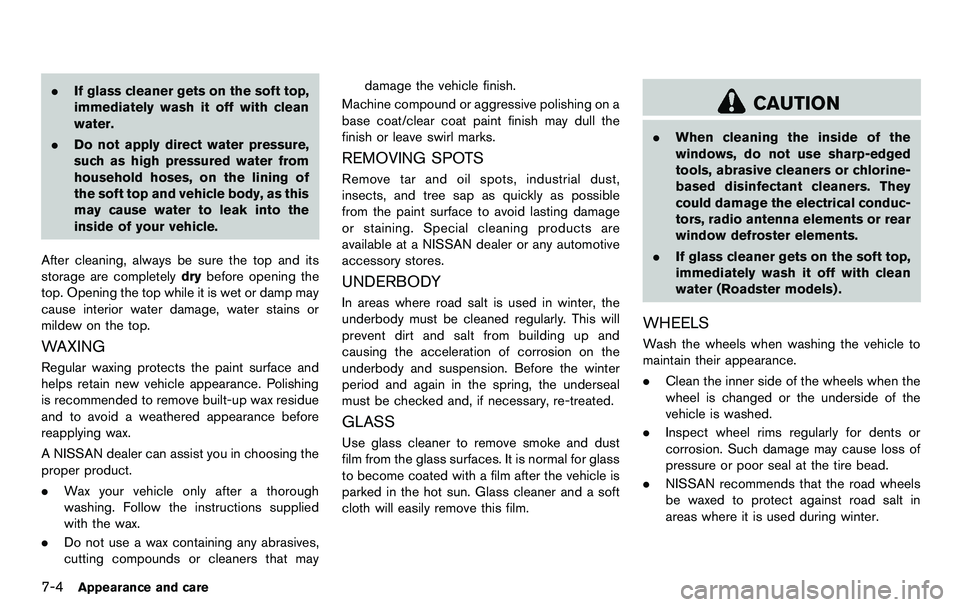
7-4Appearance and care
.If glass cleaner gets on the soft top,
immediately wash it off with clean
water.
. Do not apply direct water pressure,
such as high pressured water from
household hoses, on the lining of
the soft top and vehicle body, as this
may cause water to leak into the
inside of your vehicle.
After cleaning, always be sure the top and its
storage are completely drybefore opening the
top. Opening the top while it is wet or damp may
cause interior water damage, water stains or
mildew on the top.
WAXING
Regular waxing protects the paint surface and
helps retain new vehicle appearance. Polishing
is recommended to remove built-up wax residue
and to avoid a weathered appearance before
reapplying wax.
A NISSAN dealer can assist you in choosing the
proper product.
. Wax your vehicle only after a thorough
washing. Follow the instructions supplied
with the wax.
. Do not use a wax containing any abrasives,
cutting compounds or cleaners that may damage the vehicle finish.
Machine compound or aggressive polishing on a
base coat/clear coat paint finish may dull the
finish or leave swirl marks.
REMOVING SPOTS
Remove tar and oil spots, industrial dust,
insects, and tree sap as quickly as possible
from the paint surface to avoid lasting damage
or staining. Special cleaning products are
available at a NISSAN dealer or any automotive
accessory stores.
UNDERBODY
In areas where road salt is used in winter, the
underbody must be cleaned regularly. This will
prevent dirt and salt from building up and
causing the acceleration of corrosion on the
underbody and suspension. Before the winter
period and again in the spring, the underseal
must be checked and, if necessary, re-treated.
GLASS
Use glass cleaner to remove smoke and dust
film from the glass surfaces. It is normal for glass
to become coated with a film after the vehicle is
parked in the hot sun. Glass cleaner and a soft
cloth will easily remove this film.
CAUTION
. When cleaning the inside of the
windows, do not use sharp-edged
tools, abrasive cleaners or chlorine-
based disinfectant cleaners. They
could damage the electrical conduc-
tors, radio antenna elements or rear
window defroster elements.
. If glass cleaner gets on the soft top,
immediately wash it off with clean
water (Roadster models) .
WHEELS
Wash the wheels when washing the vehicle to
maintain their appearance.
.Clean the inner side of the wheels when the
wheel is changed or the underside of the
vehicle is washed.
. Inspect wheel rims regularly for dents or
corrosion. Such damage may cause loss of
pressure or poor seal at the tire bead.
. NISSAN recommends that the road wheels
be waxed to protect against road salt in
areas where it is used during winter.
Page 363 of 427
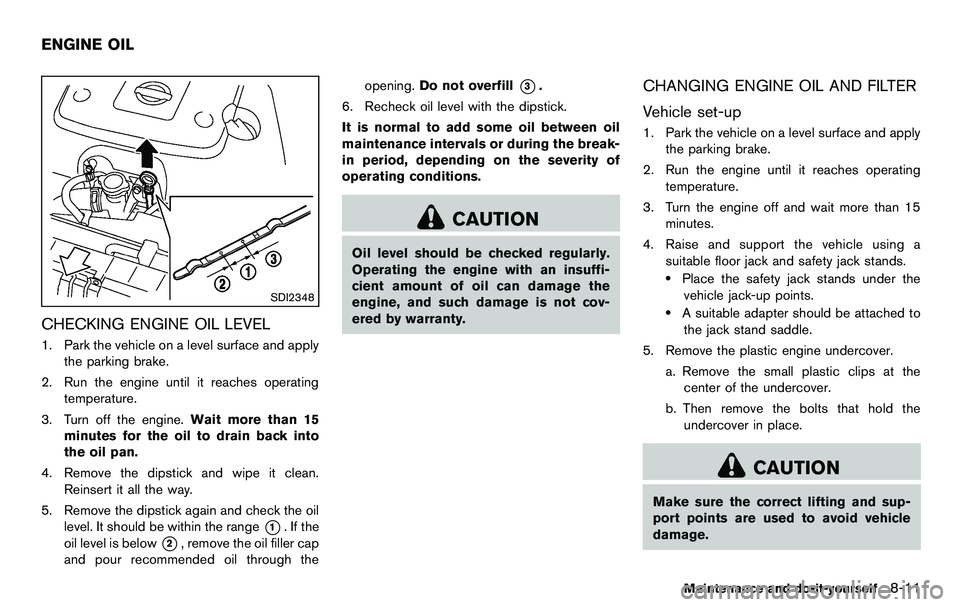
SDI2348
CHECKING ENGINE OIL LEVEL
1. Park the vehicle on a level surface and applythe parking brake.
2. Run the engine until it reaches operating temperature.
3. Turn off the engine. Wait more than 15
minutes for the oil to drain back into
the oil pan.
4. Remove the dipstick and wipe it clean. Reinsert it all the way.
5. Remove the dipstick again and check the oil level. It should be within the range
*1. If the
oil level is below
*2, remove the oil filler cap
and pour recommended oil through the opening.
Do not overfill
*3.
6. Recheck oil level with the dipstick.
It is normal to add some oil between oil
maintenance intervals or during the break-
in period, depending on the severity of
operating conditions.
CAUTION
Oil level should be checked regularly.
Operating the engine with an insuffi-
cient amount of oil can damage the
engine, and such damage is not cov-
ered by warranty.
CHANGING ENGINE OIL AND FILTER
Vehicle set-up
1. Park the vehicle on a level surface and apply the parking brake.
2. Run the engine until it reaches operating temperature.
3. Turn the engine off and wait more than 15 minutes.
4. Raise and support the vehicle using a suitable floor jack and safety jack stands.
.Place the safety jack stands under the
vehicle jack-up points.
.A suitable adapter should be attached tothe jack stand saddle.
5. Remove the plastic engine undercover. a. Remove the small plastic clips at thecenter of the undercover.
b. Then remove the bolts that hold the undercover in place.
CAUTION
Make sure the correct lifting and sup-
port points are used to avoid vehicle
damage.
Maintenance and do-it-yourself8-11
ENGINE OIL
Page 364 of 427
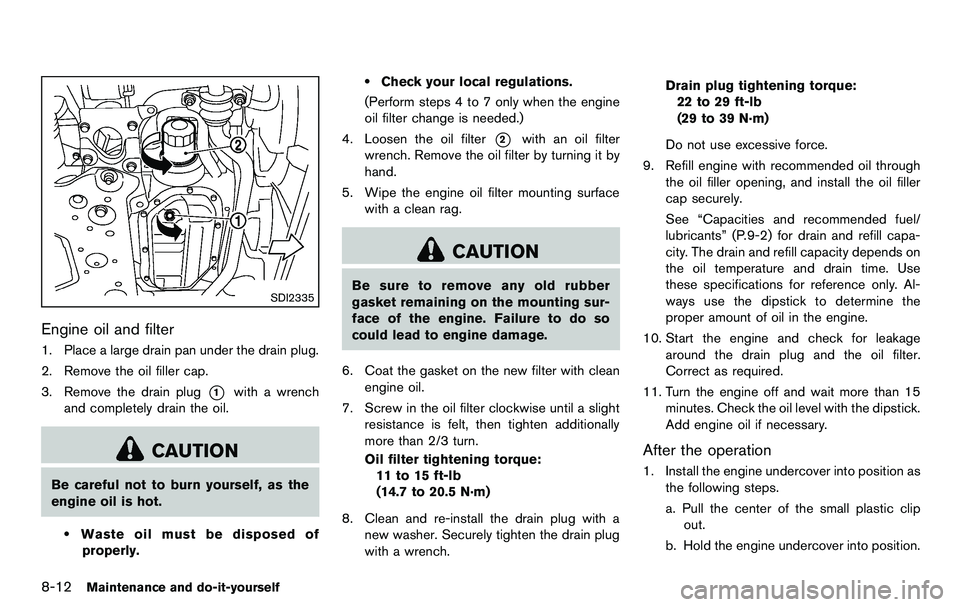
8-12Maintenance and do-it-yourself
SDI2335
Engine oil and filter
1. Place a large drain pan under the drain plug.
2. Remove the oil filler cap.
3. Remove the drain plug
*1with a wrench
and completely drain the oil.
CAUTION
Be careful not to burn yourself, as the
engine oil is hot.
.Waste oil must be disposed of
properly.
.Check your local regulations.
(Perform steps 4 to 7 only when the engine
oil filter change is needed.)
4. Loosen the oil filter
*2with an oil filter
wrench. Remove the oil filter by turning it by
hand.
5. Wipe the engine oil filter mounting surface with a clean rag.
CAUTION
Be sure to remove any old rubber
gasket remaining on the mounting sur-
face of the engine. Failure to do so
could lead to engine damage.
6. Coat the gasket on the new filter with clean engine oil.
7. Screw in the oil filter clockwise until a slight resistance is felt, then tighten additionally
more than 2/3 turn.
Oil filter tightening torque:11 to 15 ft-lb
(14.7 to 20.5 N·m)
8. Clean and re-install the drain plug with a new washer. Securely tighten the drain plug
with a wrench. Drain plug tightening torque:
22 to 29 ft-lb
(29 to 39 N·m)
Do not use excessive force.
9. Refill engine with recommended oil through the oil filler opening, and install the oil filler
cap securely.
See “Capacities and recommended fuel/
lubricants” (P.9-2) for drain and refill capa-
city. The drain and refill capacity depends on
the oil temperature and drain time. Use
these specifications for reference only. Al-
ways use the dipstick to determine the
proper amount of oil in the engine.
10. Start the engine and check for leakage around the drain plug and the oil filter.
Correct as required.
11. Turn the engine off and wait more than 15 minutes. Check the oil level with the dipstick.
Add engine oil if necessary.
After the operation
1. Install the engine undercover into position asthe following steps.
a. Pull the center of the small plastic clipout.
b. Hold the engine undercover into position.
Page 395 of 427
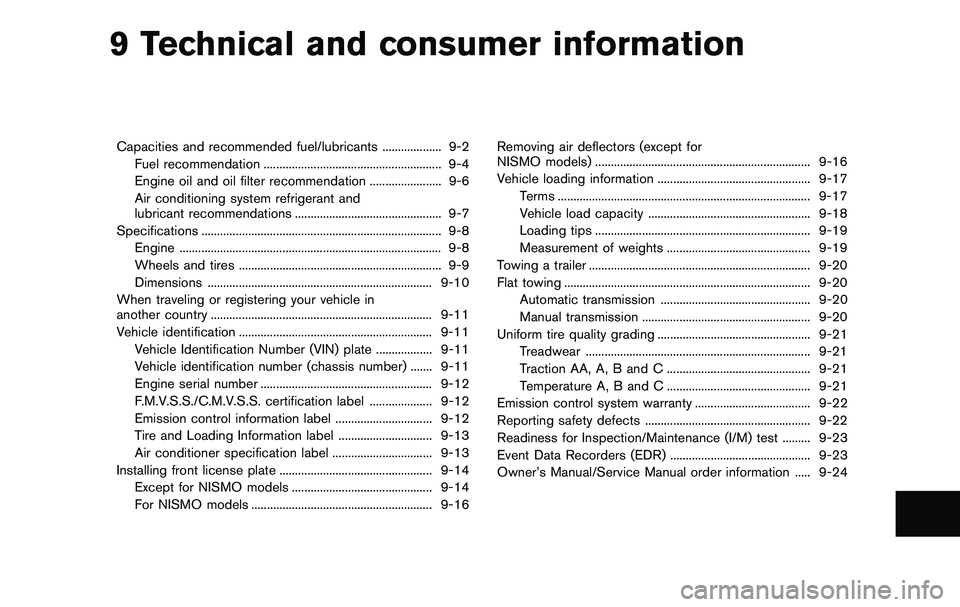
9 Technical and consumer information
Capacities and recommended fuel/lubricants ................... 9-2Fuel recommendation ......................................................... 9-4
Engine oil and oil filter recommendation ....................... 9-6
Air conditioning system refrigerant and
lubricant recommendations ............................................... 9-7
Specifications ........................................................................\
..... 9-8
Engine ........................................................................\
............ 9-8
Wheels and tires ................................................................. 9-9
Dimensions ........................................................................\
9-10
When traveling or registering your vehicle in
another country ....................................................................... 9-11
Vehicle identification .............................................................. 9-11 Vehicle Identification Number (VIN) plate .................. 9-11
Vehicle identification number (chassis number) ....... 9-11
Engine serial number ....................................................... 9-12
F.M.V.S.S./C.M.V.S.S. certification label .................... 9-12
Emission control information label ............................... 9-12
Tire and Loading Information label .............................. 9-13
Air conditioner specification label ................................ 9-13
Installing front license plate ................................................. 9-14
Except for NISMO models ............................................. 9-14
For NISMO models .......................................................... 9-16 Removing air deflectors (except for
NISMO models) ..................................................................... 9-16
Vehicle loading information ................................................. 9-17
Terms ........................................................................\
......... 9-17
Vehicle load capacity .................................................... 9-18
Loading tips ..................................................................... 9-19
Measurement of weights .............................................. 9-19
Towing a trailer ....................................................................... 9-20
Flat towing ........................................................................\
....... 9-20 Automatic transmission ................................................ 9-20
Manual transmission ...................................................... 9-20
Uniform tire quality grading ................................................. 9-21 Treadwear ........................................................................\
9-21
Traction AA, A, B and C .............................................. 9-21
Temperature A, B and C .............................................. 9-21
Emission control system warranty ..................................... 9-22
Reporting safety defects ..................................................... 9-22
Readiness for Inspection/Maintenance (I/M) test ......... 9-23
Event Data Recorders (EDR) ............................................. 9-23
Owner’s Manual/Service Manual order information ..... 9-24
Page 396 of 427
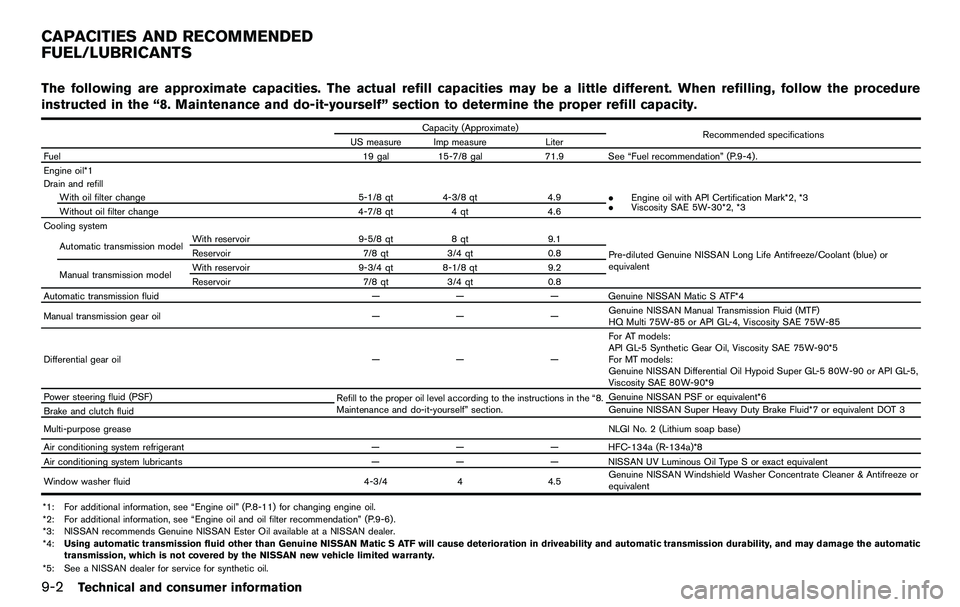
9-2Technical and consumer information
The following are approximate capacities. The actual refill capacities may be a little different. When refilling, follow the procedure
instructed in the “8. Maintenance and do-it-yourself” section to determine the proper refill capacity.
Capacity (Approximate)Recommended specifications
US measure Imp measure Liter
Fuel 19 gal 15-7/8 gal 71.9 See “Fuel recommendation” (P.9-4).
Engine oil*1
Drain and refill With oil filter change 5-1/8 qt 4-3/8 qt 4.9 .Engine oil with API Certification Mark*2, *3
. Viscosity SAE 5W-30*2, *3
Without oil filter change 4-7/8 qt 4 qt 4.6
Cooling system
Automatic transmission model With reservoir
9-5/8 qt8 qt 9.1
Pre-diluted Genuine NISSAN Long Life Antifreeze/Coolant (blue) or
equivalent
Reservoir
7/8 qt3/4 qt 0.8
Manual transmission model With reservoir
9-3/4 qt8-1/8 qt 9.2
Reservoir 7/8 qt3/4 qt 0.8
Automatic transmission fluid —— —Genuine NISSAN Matic S ATF*4
Manual transmission gear oil —— —Genuine NISSAN Manual Transmission Fluid (MTF)
HQ Multi 75W-85 or API GL-4, Viscosity SAE 75W-85
Differential gear oil —— —For AT models:
API GL-5 Synthetic Gear Oil, Viscosity SAE 75W-90*5
For MT models:
Genuine NISSAN Differential Oil Hypoid Super GL-5 80W-90 or API GL-5,
Viscosity SAE 80W-90*9
Power steering fluid (PSF) Refill to the proper oil level according to the instructions in the “8.
Maintenance and do-it-yourself” section.Genuine NISSAN PSF or equivalent*6
Brake and clutch fluid Genuine NISSAN Super Heavy Duty Brake Fluid*7 or equivalent DOT 3
Multi-purpose grease NLGI No. 2 (Lithium soap base)
Air conditioning system refrigerant —— —HFC-134a (R-134a)*8
Air conditioning system lubricants —— —NISSAN UV Luminous Oil Type S or exact equivalent
Window washer fluid 4-3/444.5Genuine NISSAN Windshield Washer Concentrate Cleaner & Antifreeze or
equivalent
*1: For additional information, see “Engine oil” (P.8-11) for changing engine oil.
*2: For additional information, see “Engine oil and oil filter recommendation” (P.9-6).
*3: NISSAN recommends Genuine NISSAN Ester Oil available at a NISSAN dealer.
*4: Using automatic transmission fluid other than Genuine NISSAN Matic S ATF will cause deterioration in driveability and automatic transmission durability, and may damage the automatic
transmission, which is not covered by the NISSAN new vehicle limited warranty.
*5: See a NISSAN dealer for service for synthetic oil.
CAPACITIES AND RECOMMENDED
FUEL/LUBRICANTS
Page 400 of 427
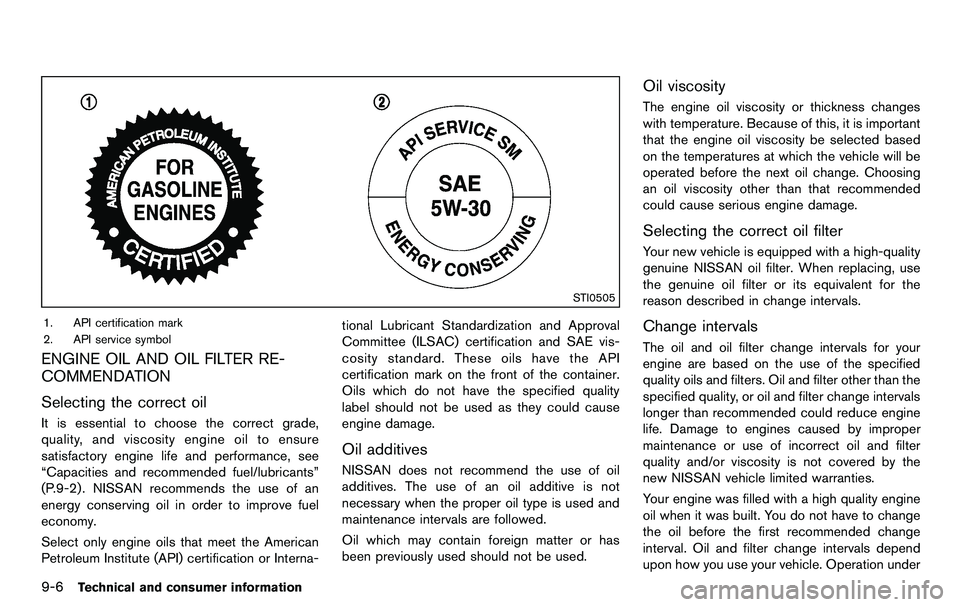
9-6Technical and consumer information
STI0505
1. API certification mark
2. API service symbol
ENGINE OIL AND OIL FILTER RE-
COMMENDATION
Selecting the correct oil
It is essential to choose the correct grade,
quality, and viscosity engine oil to ensure
satisfactory engine life and performance, see
“Capacities and recommended fuel/lubricants”
(P.9-2) . NISSAN recommends the use of an
energy conserving oil in order to improve fuel
economy.
Select only engine oils that meet the American
Petroleum Institute (API) certification or Interna-tional Lubricant Standardization and Approval
Committee (ILSAC) certification and SAE vis-
cosity standard. These oils have the API
certification mark on the front of the container.
Oils which do not have the specified quality
label should not be used as they could cause
engine damage.
Oil additives
NISSAN does not recommend the use of oil
additives. The use of an oil additive is not
necessary when the proper oil type is used and
maintenance intervals are followed.
Oil which may contain foreign matter or has
been previously used should not be used.
Oil viscosity
The engine oil viscosity or thickness changes
with temperature. Because of this, it is important
that the engine oil viscosity be selected based
on the temperatures at which the vehicle will be
operated before the next oil change. Choosing
an oil viscosity other than that recommended
could cause serious engine damage.
Selecting the correct oil filter
Your new vehicle is equipped with a high-quality
genuine NISSAN oil filter. When replacing, use
the genuine oil filter or its equivalent for the
reason described in change intervals.
Change intervals
The oil and oil filter change intervals for your
engine are based on the use of the specified
quality oils and filters. Oil and filter other than the
specified quality, or oil and filter change intervals
longer than recommended could reduce engine
life. Damage to engines caused by improper
maintenance or use of incorrect oil and filter
quality and/or viscosity is not covered by the
new NISSAN vehicle limited warranties.
Your engine was filled with a high quality engine
oil when it was built. You do not have to change
the oil before the first recommended change
interval. Oil and filter change intervals depend
upon how you use your vehicle. Operation under
Page 420 of 427
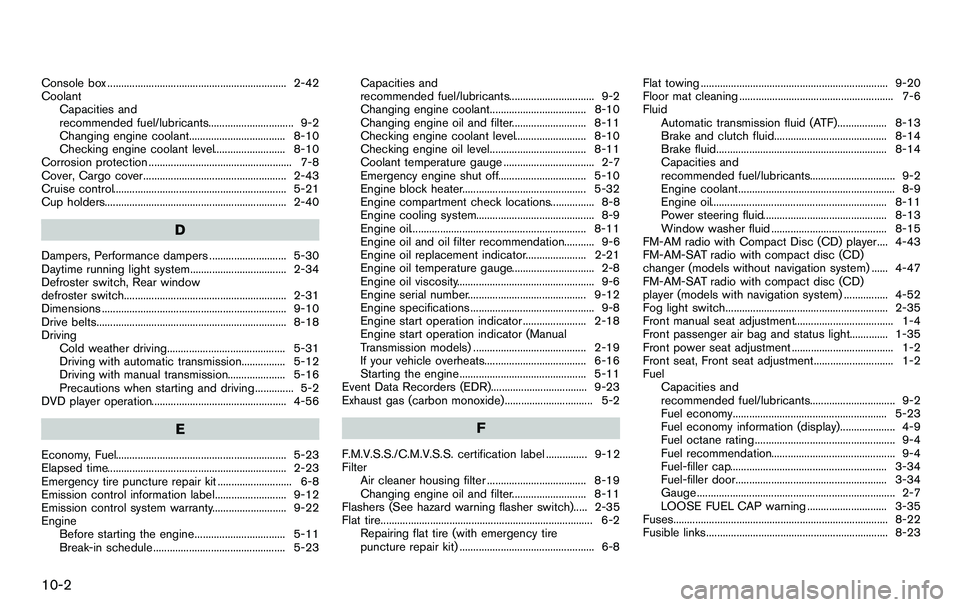
10-2
Console box ................................................................. 2-42
CoolantCapacities and
recommended fuel/lubricants............................... 9-2
Changing engine coolant................................... 8-10
Checking engine coolant level.......................... 8-10
Corrosion protection .................................................... 7-8
Cover, Cargo cover.................................................... 2-43
Cruise control............................................................... 5-21
Cup holders.................................................................. 2-40
D
Dampers, Performance dampers ............................ 5-30
Daytime running light system................................... 2-34
Defroster switch, Rear window
defroster switch........................................................... 2-31
Dimensions ................................................................... 9-10
Drive belts..................................................................... 8-18
Driving Cold weather driving........................................... 5-31
Driving with automatic transmission................ 5-12
Driving with manual transmission..................... 5-16
Precautions when starting and driving .............. 5-2
DVD player operation................................................. 4-56
E
Economy, Fuel.............................................................. 5-23
Elapsed time................................................................. 2-23
Emergency tire puncture repair kit ........................... 6-8
Emission control information label.......................... 9-12
Emission control system warranty........................... 9-22
Engine Before starting the engine................................. 5-11
Break-in schedule ................................................ 5-23 Capacities and
recommended fuel/lubricants............................... 9-2
Changing engine coolant................................... 8-10
Changing engine oil and filter........................... 8-11
Checking engine coolant level.......................... 8-10
Checking engine oil level................................... 8-11
Coolant temperature gauge ................................. 2-7
Emergency engine shut off................................ 5-10
Engine block heater............................................. 5-32
Engine compartment check locations................ 8-8
Engine cooling system........................................... 8-9
Engine oil................................................................ 8-11
Engine oil and oil filter recommendation........... 9-6
Engine oil replacement indicator...................... 2-21
Engine oil temperature gauge.............................. 2-8
Engine oil viscosity.................................................. 9-6
Engine serial number........................................... 9-12
Engine specifications ............................................. 9-8
Engine start operation indicator ....................... 2-18
Engine start operation indicator (Manual
Transmission models) ......................................... 2-19
If your vehicle overheats..................................... 6-16
Starting the engine .............................................. 5-11
Event Data Recorders (EDR)................................... 9-23
Exhaust gas (carbon monoxide)................................ 5-2
F
F.M.V.S.S./C.M.V.S.S. certification label ............... 9-12
Filter Air cleaner housing filter .................................... 8-19
Changing engine oil and filter........................... 8-11
Flashers (See hazard warning flasher switch)..... 2-35
Flat tire............................................................................. 6-2 Repairing flat tire (with emergency tire
puncture repair kit) ................................................. 6-8 Flat towing .................................................................... 9-20
Floor mat cleaning ........................................................ 7-6
Fluid Automatic transmission fluid (ATF).................. 8-13
Brake and clutch fluid......................................... 8-14
Brake fluid.............................................................. 8-14
Capacities and
recommended fuel/lubricants............................... 9-2
Engine coolant......................................................... 8-9
Engine oil................................................................ 8-11
Power steering fluid............................................. 8-13
Window washer fluid .......................................... 8-15
FM-AM radio with Compact Disc (CD) player.... 4-43
FM-AM-SAT radio with compact disc (CD)
changer (models without navigation system) ...... 4-47
FM-AM-SAT radio with compact disc (CD)
player (models with navigation system) ................ 4-52
Fog light switch........................................................... 2-35
Front manual seat adjustment.................................... 1-4
Front passenger air bag and status light.............. 1-35
Front power seat adjustment ..................................... 1-2
Front seat, Front seat adjustment............................. 1-2
Fuel Capacities and
recommended fuel/lubricants............................... 9-2
Fuel economy........................................................ 5-23
Fuel economy information (display).................... 4-9
Fuel octane rating ................................................... 9-4
Fuel recommendation............................................. 9-4
Fuel-filler cap......................................................... 3-34
Fuel-filler door....................................................... 3-34
Gauge ........................................................................ 2-7
LOOSE FUEL CAP warning ............................. 3-35
Fuses.............................................................................. 8-22
Fusible links.................................................................. 8-23
Page 422 of 427
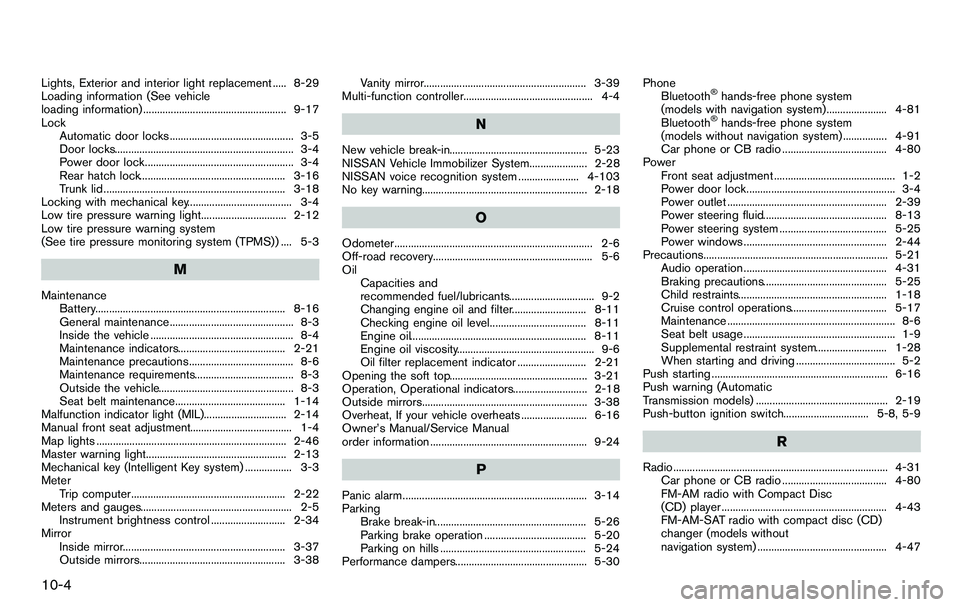
10-4
Lights, Exterior and interior light replacement ..... 8-29
Loading information (See vehicle
loading information) .................................................... 9-17
LockAutomatic door locks ............................................. 3-5
Door locks................................................................. 3-4
Power door lock...................................................... 3-4
Rear hatch lock..................................................... 3-16
Trunk lid .................................................................. 3-18
Locking with mechanical key...................................... 3-4
Low tire pressure warning light............................... 2-12
Low tire pressure warning system
(See tire pressure monitoring system (TPMS)) .... 5-3
M
Maintenance Battery..................................................................... 8-16
General maintenance ............................................. 8-3
Inside the vehicle .................................................... 8-4
Maintenance indicators....................................... 2-21
Maintenance precautions...................................... 8-6
Maintenance requirements.................................... 8-3
Outside the vehicle................................................. 8-3
Seat belt maintenance........................................ 1-14
Malfunction indicator light (MIL).............................. 2-14
Manual front seat adjustment..................................... 1-4
Map lights ..................................................................... 2-46
Master warning light................................................... 2-13
Mechanical key (Intelligent Key system) ................. 3-3
Meter Trip computer........................................................ 2-22
Meters and gauges....................................................... 2-5 Instrument brightness control ........................... 2-34
Mirror Inside mirror........................................................... 3-37
Outside mirrors..................................................... 3-38 Vanity mirror........................................................... 3-39
Multi-function controller............................................... 4-4
N
New vehicle break-in.................................................. 5-23
NISSAN Vehicle Immobilizer System..................... 2-28
NISSAN voice recognition system ...................... 4-103
No key warning............................................................ 2-18
O
Odometer........................................................................ 2-6
Off-road recovery.......................................................... 5-6
Oil Capacities and
recommended fuel/lubricants............................... 9-2
Changing engine oil and filter........................... 8-11
Checking engine oil level................................... 8-11
Engine oil................................................................ 8-11
Engine oil viscosity.................................................. 9-6
Oil filter replacement indicator ......................... 2-21
Opening the soft top.................................................. 3-21
Operation, Operational indicators........................... 2-18
Outside mirrors............................................................ 3-38
Overheat, If your vehicle overheats ........................ 6-16
Owner’s Manual/Service Manual
order information ......................................................... 9-24
P
Panic alarm................................................................... 3-14
Parking Brake break-in....................................................... 5-26
Parking brake operation ..................................... 5-20
Parking on hills ..................................................... 5-24
Performance dampers................................................ 5-30 Phone
Bluetooth
®hands-free phone system
(models with navigation system)...................... 4-81
Bluetooth
®hands-free phone system
(models without navigation system) ................ 4-91
Car phone or CB radio ...................................... 4-80
Power Front seat adjustment ............................................ 1-2
Power door lock...................................................... 3-4
Power outlet .......................................................... 2-39
Power steering fluid............................................. 8-13
Power steering system ....................................... 5-25
Power windows .................................................... 2-44
Precautions................................................................... 5-21 Audio operation .................................................... 4-31
Braking precautions............................................. 5-25
Child restraints...................................................... 1-18
Cruise control operations................................... 5-17
Maintenance ............................................................. 8-6
Seat belt usage ....................................................... 1-9
Supplemental restraint system.......................... 1-28
When starting and driving .................................... 5-2
Push starting ................................................................ 6-16
Push warning (Automatic
Transmission models) ................................................ 2-19
Push-button ignition switch............................... 5-8, 5-9
R
Radio.............................................................................. 4-31 Car phone or CB radio ...................................... 4-80
FM-AM radio with Compact Disc
(CD) player ............................................................ 4-43
FM-AM-SAT radio with compact disc (CD)
changer (models without
navigation system) ............................................... 4-47